13-3 Observations of star-forming regions reveal that our Galaxy has spiral arms
The galaxies shown in Figure 13-9 and Figure 13-11 both have spiral arms, spiral-shaped concentrations of gas and dust that extend outward from the center in a shape reminiscent of a pinwheel. Although we cannot see the precise shape of the Milky Way because we are inside it, we believe that the Milky Way Galaxy also has spiral arms. Because interstellar dust obscures our visible-light view in the plane of our Galaxy, a detailed understanding of the structure of the galactic disk did not occur until the development of radio astronomy. Thanks to their long wavelengths, radio waves can penetrate the interstellar medium even more easily than infrared light and can travel without being scattered or absorbed. As we will see in this section, both radio and optical observations reveal that our Galaxy does indeed have spiral arms.
Mapping Hydrogen in the Milky Way with Radio Waves
Hydrogen is by far the most abundant element in the universe. Hence, by looking for concentrations of hydrogen gas, we should be able to detect important clues about the distribution of matter in our Galaxy. Unfortunately, ordinary visible-light telescopes are of little use in this quest. This is so because hydrogen atoms can only emit visible light if their electrons are first excited to high energy levels. This is quite unlikely to occur in the cold depths of interstellar space. Furthermore, even if there are some hydrogen atoms that glow strongly at visible wavelengths, interstellar dust would make it impossible to see this glow from distant parts of the Galaxy.
What makes it possible to map out the distribution of hydrogen in our Galaxy is that even cold hydrogen clouds emit radio waves. As we mentioned earlier, radio waves can easily penetrate the interstellar medium, so we can detect the radio emission from such cold clouds no matter where they lie in the Galaxy. To understand how hydrogen in these clouds can emit radio waves, we must probe a bit more deeply into the structure of protons and electrons, the particles of which hydrogen atoms are made.
In addition to having mass and charge, particles such as protons and electrons possess a tiny amount of spin (more formally described as angular momentum). Very roughly, you can visualize each of the electrons around protons in an atom as a tiny, electrically charged sphere that spins on its axis. (This idea also works for protons.) Because electric charges in motion generate magnetic fields, an electron behaves like a tiny magnet with a north pole and a south pole (Figure 13-12).
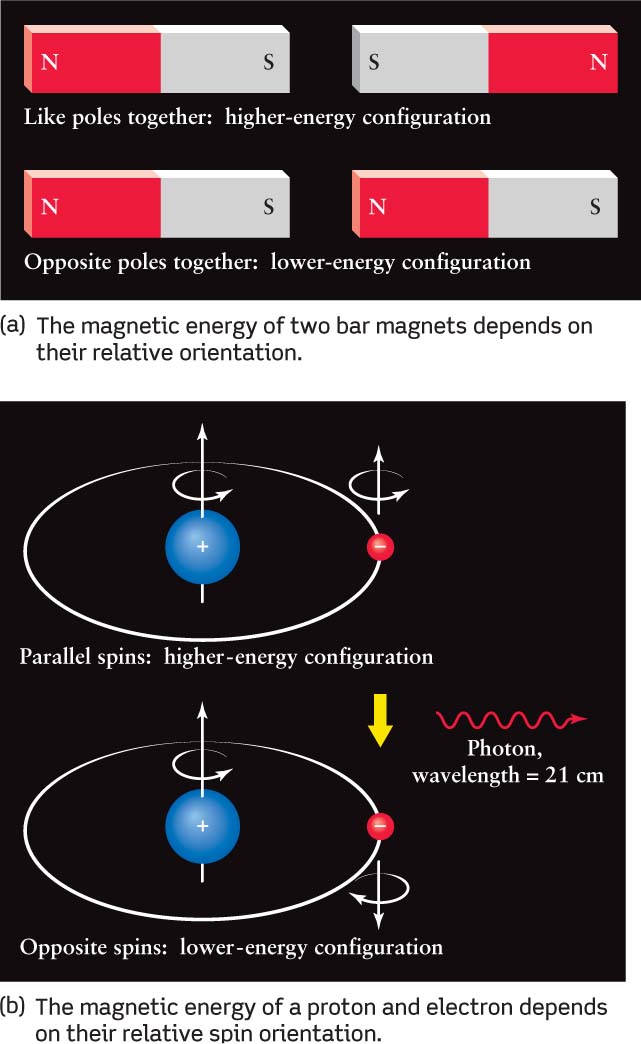
309
If you have ever played with magnets, you know that two magnets attract when the north pole of one magnet is next to the south pole of the other and repel when two like poles (both north or both south) are next to each other (Figure 13-12a). In other words, the energy of the two magnets is least when opposite poles are together and highest when like poles are together. Hence, as shown in Figure 13-12b, the energy of a hydrogen atom is slightly different, depending on whether the spins of the proton and electron are in the same direction or opposite directions. According to the laws of physics, these are the only two possibilities; the spins cannot be at random angles.
If the spin of the electron changes its orientation from the higher-energy configuration to the lower-energy one—called a spin-flip transition—a photon is emitted. The energy difference between the two spin configurations is very small, only about 10−6 times as great as those between different electron orbits. Therefore, the photon emitted in a spin-flip transition between these configurations has only a small amount of energy, and thus its wavelength is a relatively long 21 cm. What is important here is that the photon generated from hydrogen in this scenario has a wavelength of 21 cm and is in the radio wavelengths portion of the electromagnetic spectrum.
Radio waves of 21 cm are used to map our Galaxy’s spiral arms.
The distribution of hydrogen gas in the Milky Way is not uniform but is actually quite frothy. In fact, our Sun lies near the edge of an irregularly shaped region within which the interstellar medium is very thin but at very high temperatures (about 106 K). This curious region may have been carved out by a supernova that exploded nearby some 300,000 years ago.
Question
ConceptCheck 13-5: If a spin-flip transition released substantially more energy, such that a photon was emitted in the far-infrared range, would the Milky Way stretching across the night sky appear brighter or dimmer?
Question
CalculationCheck 13-1: If a 21-cm photon is observed when a single hydrogen atom undergoes a spin-flip transition, what wavelength of photon is observed when 10 hydrogen atoms undergo spin-flip transitions?
Detecting Our Galaxy’s Spiral Arms
The detection of 21-cm radio emission was a major breakthrough that permitted astronomers to reveal the presence of spiral arms in the galactic disk. Figure 13-13 illustrates how this was done. Suppose that you aim a radio telescope along a particular line of sight across the Galaxy. Your radio receiver, located at S (the position of our solar system), picks up 21-cm emission from hydrogen clouds at points 1, 2, 3, and 4. However, the radio waves from these various clouds are Doppler shifted by slightly different amounts because the clouds are moving at different speeds as they travel with our rotating Galaxy.
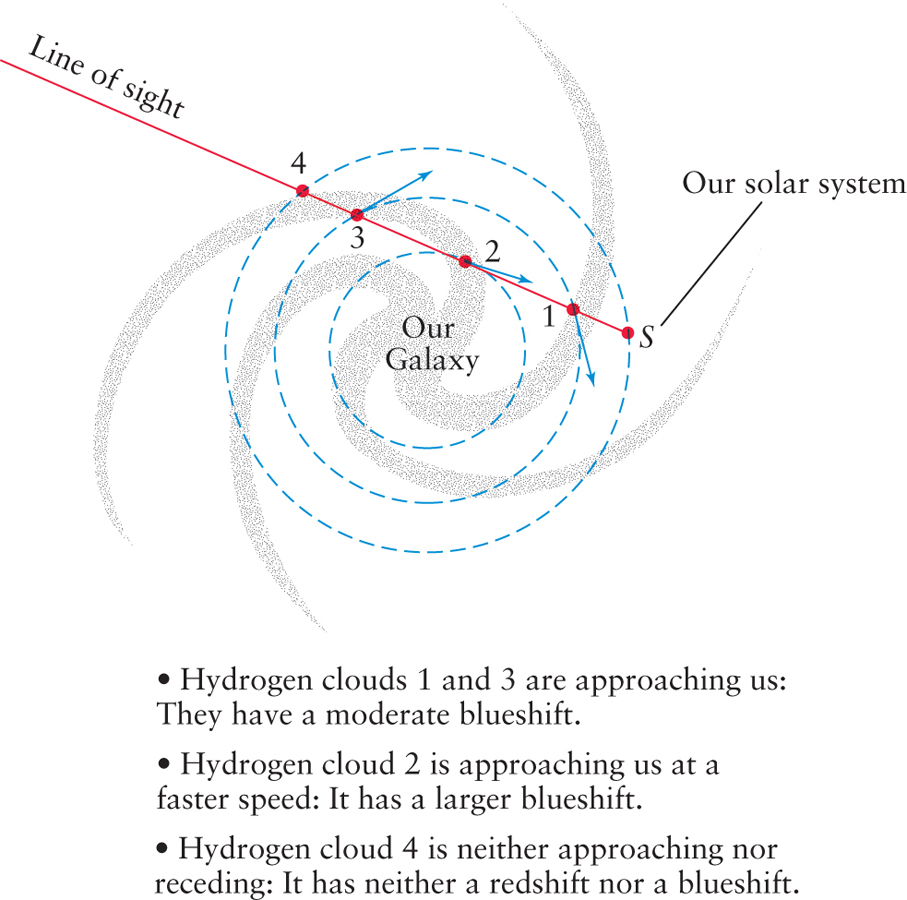
310
It is important to remember that the Doppler shift reveals only motion along the line of sight. In Figure 13-13, cloud 2 has the highest speed along our line of sight because it is moving directly toward us. Consequently, the radio waves from cloud 2 exhibit a larger Doppler shift than those from the other three clouds along our line of sight. Because clouds 1 and 3 are at the same distance from the galactic center, they have the same orbital speed. The fraction of their velocity parallel to our line of sight is also the same, so their radio waves exhibit the same Doppler shift, which is less than the Doppler shift of cloud 2. Finally, cloud 4 is the same distance from the galactic center as the Sun. This cloud is thus orbiting the Galaxy at the same speed as the Sun, resulting in no net motion along the line of sight. Radio waves from cloud 4, as well as from hydrogen gas near the Sun, are not Doppler shifted at all.
These various Doppler shifts cause radio waves from gases in different parts of the Galaxy to arrive at our radio telescopes with wavelengths slightly different from 21 cm. It is therefore possible to sort out the various gas clouds and thus produce a map of the Galaxy like that shown in Figure 13-14.
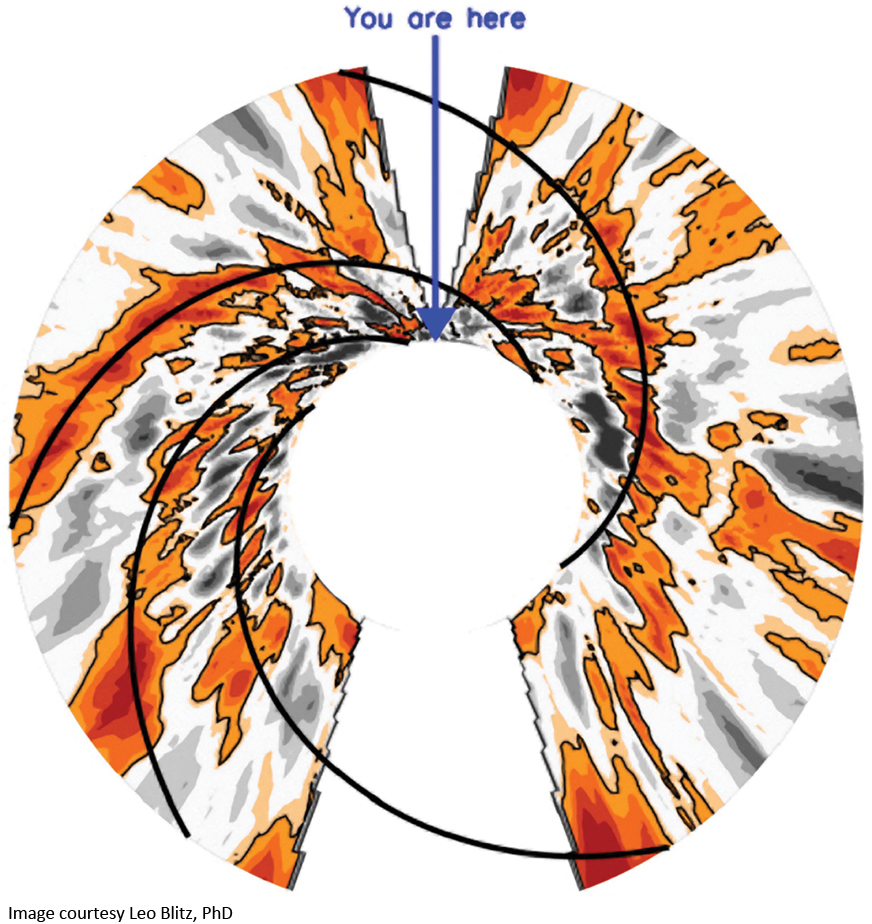
Figure 13-14 shows that this hydrogen gas is not spread uniformly around the disk of the Galaxy but is concentrated into numerous arched lanes. Similar features are seen in other galaxies beyond the Milky Way. As an example, the galaxy in Figure 13-15 has prominent spiral arms outlined by hot, luminous, blue main-sequence stars and the red emission nebulae found near many such stars. Stars of this sort are very short-lived, so these features indicate that spiral arms are sites of active, ongoing star formation. A radio telescope tuned to receive 21-cm light shows that spiral arms are also regions where hydrogen gas is concentrated, similar to the structures in our own Galaxy visible in Figure 13-14. This is a strong indication that our Galaxy also has spiral arms.
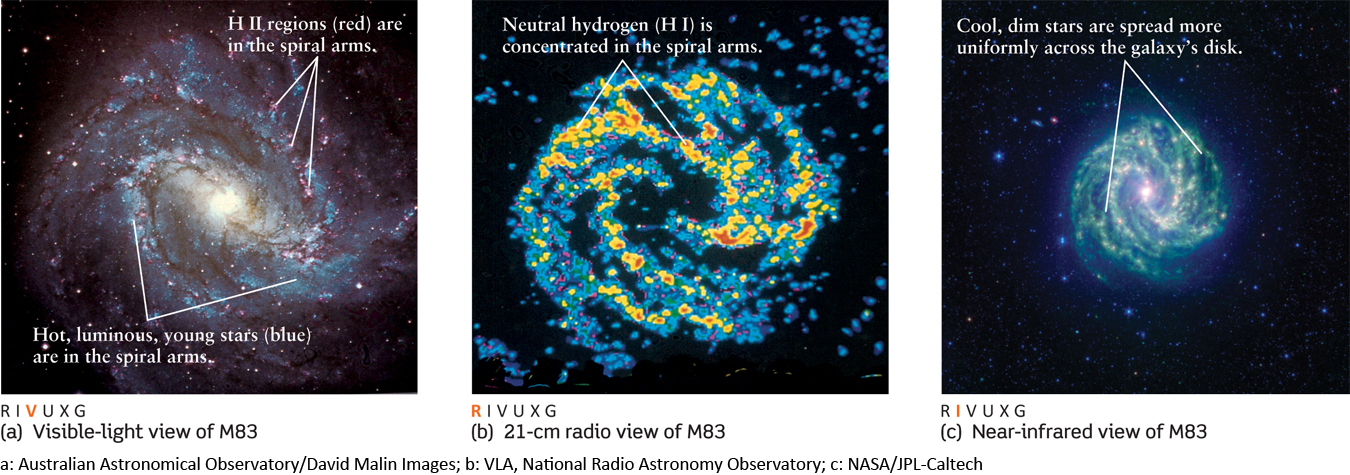
CAUTION
Photographs such as Figure 13-15a might lead to the mistaken impression that there are very few stars between the spiral arms of a galaxy. Nothing could be further from the truth! In fact, stars are distributed rather uniformly throughout the disk of a galaxy like the one in Figure 13-15a; the density of stars in the spiral arms is only about 5% higher than in the rest of the disk. The spiral arms stand out nonetheless because they are where hot, blue O and B stars are found. One such star is about 104 times more luminous than an average star in the disk, so the light from O and B stars completely dominates the visible appearance of a spiral galaxy. An infrared image such as Figure 13-15c gives a better impression of how stars of all kinds are distributed through a spiral galaxy’s disk.
311
Question
ConceptCheck 13-6: When looking at neutral hydrogen gas that is moving away from you, how is its wavelength changed as compared to hydrogen gas that is not moving relative to you?
Mapping the Spiral Arms and the Central Bulge with Visible-light Observations
Figure 13-15a suggests that we can confirm the presence of spiral structure in our own Galaxy by mapping the locations of star-forming regions. Such regions are marked by OB associations, H II regions, and molecular clouds. Unfortunately, the first two of these are best observed using visible light, and interstellar dust limits the range of visual observations in the plane of the Galaxy to less than 10,000 ly from Earth. But there are enough OB associations and H II regions within this range to plot the spiral arms in the vicinity of the Sun.
Molecular clouds are easier to observe at great distances because molecules of carbon monoxide (CO) in these clouds emit radio waves that are relatively unaffected by interstellar dust. Hence, the positions of molecular clouds have been observed even in remote corners of the Galaxy, normally uncharted. Taken together, all of these observations demonstrate that our Galaxy has at least a couple of major spiral arms as well as several shorter arm segments (Figure 13-16). The Sun is located just outside a relatively short arm segment called the Orion Arm, which includes the Orion Nebula and neighboring sites of vigorous star formation in that constellation.
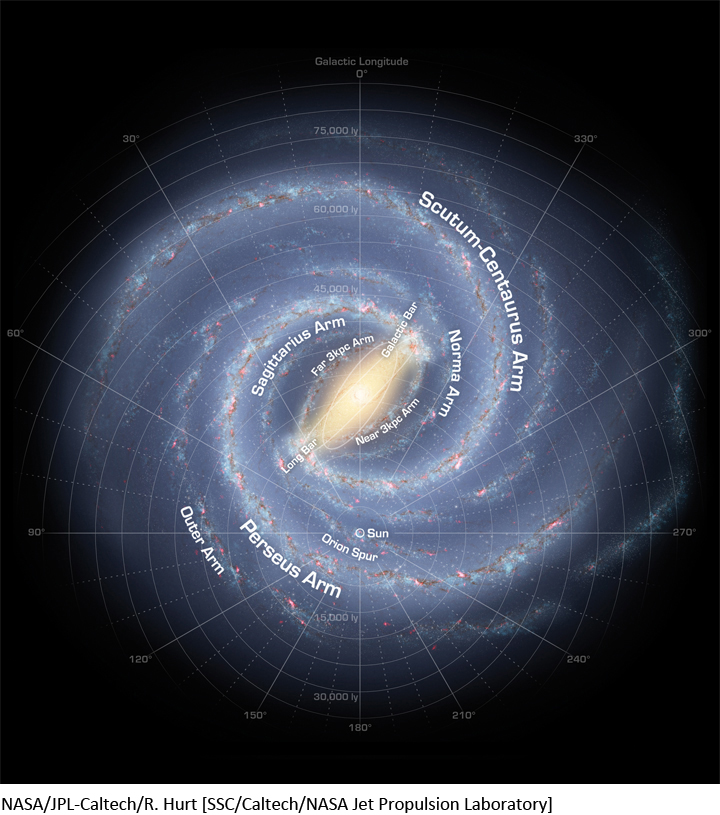
Two major spiral arms border either side of the Sun’s position. The Sagittarius Arm is on the side toward the galactic center. This is the arm you see on June and July nights when you look at the portion of the Milky Way stretching across Scorpius and Sagittarius. In December and January, when our nighttime view is directed away from the galactic center, we see the Perseus Arm. The other major spiral arms cannot be seen at visible wavelengths thanks to the obscuring effects of dust.
Figure 13-16 also shows that the central bulge of the Milky Way is not spherical, but rather is elongated like a bar. This is unlike the galaxy NGC 7331 shown in Figure 13-9, but similar to the galaxy M83 depicted in Figure 13-15. The elongated shape of the central bulge had been suspected since the 1980s; this was confirmed in 2005 using the Spitzer Space Telescope, which was used to survey the infrared emissions from some 3 million stars in the central bulge. Thus, the artist’s impression shown in Figure 13-16 is based on observations using both radio wavelengths (for the spiral arms) and infrared wavelengths (for the central bulge). As it turns out, this elongated shape may play a crucial role in sustaining the Galaxy’s spiral structure.
Why are the young stars, star-forming regions, and clouds of neutral hydrogen in our Galaxy all found predominantly in the spiral arms? To answer this question, we must understand why spiral arms exist at all. Spiral arms are essentially cosmic “traffic jams,” places where matter piles up as it orbits around the center of the Galaxy. This orbital motion, which is essential to grasping the significance of spiral arms, is our next topic as we continue our exploration of the Galaxy.
Question
Concept Check 13-7: When traveling from the edge of the galactic disk toward the galactic bulge passing nearby the Sun, what is the sequence of arms that must be traversed: Orion, Sagittarius, and Perseus?
312